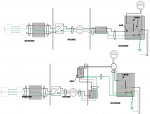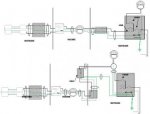The #8 continued all the way to the service panel, in this case a 200 amp panel.
So even though this was just a 30 amp circuit we still ran the #8 all the way back. Kind of a pain in the butt if you wanted to run romex and never could use the supplied #10 ground.
So my question is, can I do away with the #8 and just use the #10 ground for up to 60 amps?
Great, thanks! So load side. You mean 60A of breaker, right?

Get a 2nd opinion of this for sure, but...
#10 is good for inverter output conductors (L1,L2) up to 35A.
#10 as EGC is good as long as your output conductors are #8.
Over 35A/up to 50A of output, you use #8.
You could have a 48A inverter with a 60A breaker, that would be #8 for output and #10 for EGC.
According to 250.122, if the breaker is over 60/up to 100A, you use #8 for EGC.
However, if the breaker is over 60A, the output will be over 50A. Then you would use #6 for output and #8 for EGC.
#6 because of 310.15(B)(16), and #8 because of 250.122(B).
For a 12kW inverter, 50A of output (@240V), it's #8 with #10 EGC.
For a 15kW (largest single phase I know of), it's 62.5A of output and an 80A breaker, so you'd use #6 and #8 EGC.
1. I still can't understand why you think any of that is relevant to the subject of this thread.
2. Because of 690.47(D) in the 2014 code, which requires a grounding electrode conductor run from the array sized to 250.166. As I've said elsewhere, I'm hoping a lot of AHJs just won't enforce it. But with it in there you don't have a really clear argument.
1. Because the PV output could be connected to a 40A breaker in the main service panel, in which case there is a bus between that 40A breaker and the main service breaker.
or!
That 40A of PV OCPD could be a 40A fused switch *supply side*, with conductors (instead of bus) running from it to the service conductors and that same main service breaker.
Before the OP told us he is talking load side, it made a difference.
2. Hmm...
When the AC output of the inverter is going from the roof to the main panel...
and the EGC must be run with those PV AC output conductors...
isn't "as close as practicable"...actually within 6 feet, simply because the grounding electrode is at the main panel?
690.47(D)
(grounding electrode) at the location of all ground- and pole-mounted PV arrays and as close as practicable to the location of roof-mounted PV arrays....
----
Also-
The structure of a ground- or pole-mounted PV array shall be permitted to be considered a grounding electrode if it meets the requirements of 250.52.
ok...
250.52
(6) Other Listed Electrodes. Other listed grounding electrodes shall be permitted.
Um...which electrodes listed where?
As in... the main system electrode at the main panel where the allowed "combined (DC/AC) grounding conductor" run with the AC inverter output conductors end up? (allowed by 690.47(C)
The "combined grounding conductor" from 690.47(C)....call it a CGC?:?
And then these exceptions in 690.47(D)...?
Here we go with "integrated" again!
"integral" in No.1 and "located" in No.2...?
I find them vague. So...
It's also helpful that in the 2017 code they finally removed from 690.47 all requirements that reference grounding electrode conductors.
Yes, for sure!
Exception No.1: An array grounding electrode( s) shall
not be required where the load served by the array is integral
with the array.
Exception No.2: An additional array grounding electrode(
s) shall not be required
if located within 1.8 m (6 it)
of the premises wiring electrode.


